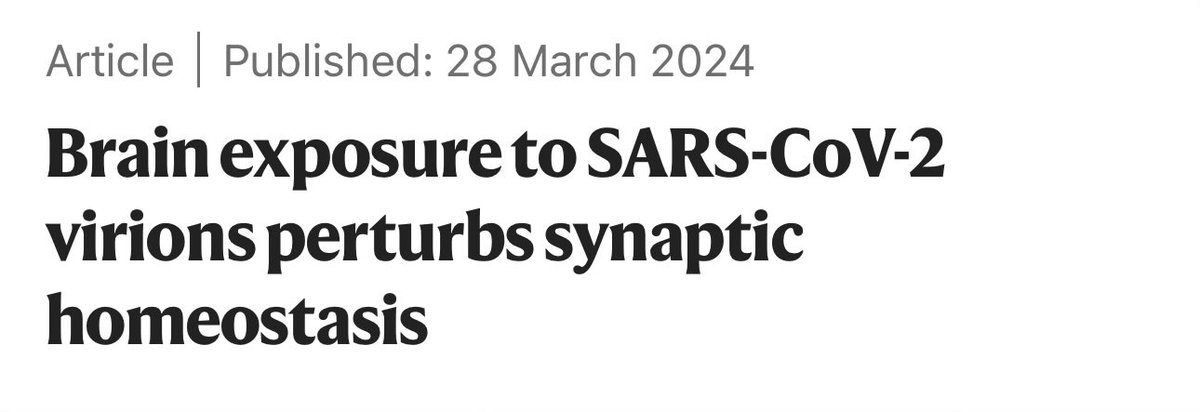SARS-CoV-2 doesn’t seek out the weak.
It manufactures them.
1/
It manufactures them.
1/
Vulnerability is not a static condition.
The vulnerable population is not a fixed group of individuals to be expunged in some misguided pursuit of societal health.
2/
The vulnerable population is not a fixed group of individuals to be expunged in some misguided pursuit of societal health.
2/
The concept of “culling” the vulnerable population with SARS-CoV-2 is a grotesque distortion of reality.
And a reflection of a profoundly flawed understanding of both biology and human society.
3/
And a reflection of a profoundly flawed understanding of both biology and human society.
3/
The vulnerable population is a dynamic and evolving demographic.
It is constantly replenished by the very effects of the virus and the structural inequalities that exacerbate its impact.
4/
It is constantly replenished by the very effects of the virus and the structural inequalities that exacerbate its impact.
4/
SARS-CoV-2 doesn’t just affect a pre-determined group of immunocompromised or elderly individuals.
It systematically creates new vulnerabilities within the population.
5/
It systematically creates new vulnerabilities within the population.
5/
With each wave, SC2 leaves in its wake long-term complications, damage to the cardiovascular, neurological, and immune systems, and chronic conditions
Those who might have been considered “healthy” before infection can rapidly transition into the category of the vulnerable
6/
Those who might have been considered “healthy” before infection can rapidly transition into the category of the vulnerable
6/
This biological reality is compounded by the socio-economic structures that disproportionately expose certain populations to the virus.
Inequality—whether economic, racial, or geographic—plays a decisive role in determining who becomes vulnerable.
7/
Inequality—whether economic, racial, or geographic—plays a decisive role in determining who becomes vulnerable.
7/
Marginalized communities, those with less access to healthcare, proper housing, and protective measures.
8/
8/
Essential workers, often in low-wage, precarious jobs, are thrust into environments where exposure is inevitable.
And where the consequences of infection—whether through the inability to afford healthcare or the long-term economic consequences of disability—are catastrophic
9/
And where the consequences of infection—whether through the inability to afford healthcare or the long-term economic consequences of disability—are catastrophic
9/
To speak of “culling” the vulnerable without addressing the systemic inequalities that constantly create and sustain this vulnerability is a moral failure.
A perverse fantasy born from ignorance and a profound lack of empathy.
10/
A perverse fantasy born from ignorance and a profound lack of empathy.
10/
The logic of eliminating the weak becomes a mechanism for perpetuating injustice.
The poor, the marginalized, and those disadvantaged by society’s inequities are continually pushed to the front lines of exposure and consequence.
11/
The poor, the marginalized, and those disadvantaged by society’s inequities are continually pushed to the front lines of exposure and consequence.
11/
This isn’t a problem that ends with any number of deaths.
It’s a feedback loop in which inequality ensures that the vulnerable population is endlessly replenished.
12/
It’s a feedback loop in which inequality ensures that the vulnerable population is endlessly replenished.
12/
The notion that society could somehow “rid itself” of vulnerability through exposure or infection presupposes a brutal, survival-of-the-fittest worldview.
Scientifically ignorant and ethically abhorrent.
13/
Scientifically ignorant and ethically abhorrent.
13/
The idea of “fitness” in the context of SC2 is a fallacy.
Variants emerge, adapt, and evade immunity, constantly shifting the goalposts of who is at risk.
14/
Variants emerge, adapt, and evade immunity, constantly shifting the goalposts of who is at risk.
14/
What was once a manageable infection for one group becomes deadly for another as SC2 evolves
As long as SARS-CoV-2 remains in circulation, the vulnerable population is not a static group of individuals to be culled, but a dynamic demographic
A reflection of the virus’s power to inflict continuous and compounding harm on society
15/
As long as SARS-CoV-2 remains in circulation, the vulnerable population is not a static group of individuals to be culled, but a dynamic demographic
A reflection of the virus’s power to inflict continuous and compounding harm on society
15/
The brutal truth is this:
As long as we accept the virus as a tool for weeding out the vulnerable, we are accepting an unending cycle of human suffering, reinforced by the very inequalities that define modern society.
16/
As long as we accept the virus as a tool for weeding out the vulnerable, we are accepting an unending cycle of human suffering, reinforced by the very inequalities that define modern society.
16/
This is not a strategy for survival or societal resilience.
It is a strategy for perpetuating exploitation and creating ever-deepening divides between the protected few and the expendable many.
17/
It is a strategy for perpetuating exploitation and creating ever-deepening divides between the protected few and the expendable many.
17/
In the end, no one—regardless of their present “health” or “fitness”—is truly exempt from this cycle.
Vulnerability, in the context of a virus that causes long-term systemic damage, is everyone’s eventual fate.
18/
Vulnerability, in the context of a virus that causes long-term systemic damage, is everyone’s eventual fate.
18/
Humanity shouldn’t be stripped of empathy and understanding.
The value of human life shouldn’t be reduced to a brutal calculus of short-term survival.
The solution does not lie in “culling” the vulnerable.
It lies in protecting and uplifting them.
19/19
The value of human life shouldn’t be reduced to a brutal calculus of short-term survival.
The solution does not lie in “culling” the vulnerable.
It lies in protecting and uplifting them.
19/19
• • •
Missing some Tweet in this thread? You can try to
force a refresh





